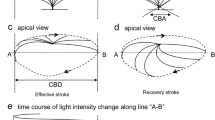Abstract
Purpose. To test two in vitro human nasal epithelial cell culture systems for their ability to screen the effects of pharmaceutical compounds on ciliary beating.
Methods. Human nasal epithelial cells were cultured as monolayer and in a sequential monolayer-suspension culture with in vitro ciliogenesis. The influence of reference cilio-stimulatory compounds (glycocholate, isoprenaline), reference cilio-inhibitory compounds (chlorocresol, diphenhydramine) and pH on ciliary beating was investigated using computerized microscope photometry.
Results. Sodium glycocholate (0.5% w/v) maximally and reversibly increased CBF of the cells in both culture systems by 26 ± 4% (monolayer) and 18 ± 6% (suspension). Similarly, isoprenaline (10-3 M) maximally, but irreversibly increased CBF of the cells by 14 ± 3% (monolayer) and 17 ± 4% (suspension). Chlorocresol (0.005% w/ v) reversibly reduced the CBF of the cells by 50 ± 6% (monolayer) and 34 ± 4% (suspension); at a higher concentration (0.1% w/v) it resulted in instantaneous and irreversible ciliostasis. Diphenhydramine (0.1% w/v) reversibly reduced CBF in both culture systems by 45 ± 13% (monolayer) and 69 ± 5% (suspension); irreversible cilio-stasis occurred in less than 2 minutes in both culture systems upon cell exposure to diphenhydramine (1.0% w/v). In the monolayer culture system, CBF was stable only within the physiological pH range of 6.5−8.0; ciliary beating in the suspension culture remained stable within a pH range of 4.0−10.0.
Conclusions. Both cell culture systems are suitable for screening the effects of pharmaceutical compounds on ciliary beating. Especially the sequential monolayer-suspension culture appears to be very promising as ciliary activity can be preserved for as long as 6 months.
Similar content being viewed by others
REFERENCES
M. Jorissen and A. Bessems. Normal ciliary beat frequency after ciliogenesis in nasal epithelial cells cultured sequentially as monolayer and in suspension. Acta Otolaryngol. (Stockh) 115:66-70 (1995).
W. A. J. J. Hermens and F. W. H. M. Merkus. The influence of drugs on nasal ciliary movement. Pharm. Res. 4:445-449 (1987).
B. Yang, T. V. Mc Caffrey, and E. B. Kern. Cryopreservation of human nasal ciliated epithelium. Am. J. Rhinol. 10:291-297 (1996).
M. Jorissen, J. De Brouwer, A. Bessems, and J. J. Cassiman. Quantification of ciliary beat frequency by computerized microscope photometry—a preliminary study on suspension cultures of human nasal epithelia showing spontaneous ciliogenesis in vitro. Leitz, Scientific and Technical information 10:88-93 (1992).
U. Werner and T. Kissel. In vitro cell culture models of the nasal epithelium: a comparative histochemical investigation of their suitability for drug transport studies. Pharm. Res. 13:978-988 (1996).
G. M. Grass. Simulation models to predict oral drug absorption from in vitro data. Adv. Drug Del. Rev. 12:199-219 (1997).
A. Wanner. Allergic mucociliary dysfunction. Laryngoscope 93:68-70 (1983).
W. A. Hermens, P. M. Hooymans, J. C. Verhoef, and F. W. Merkus. Effect of absorption enhancers on human nasal tissue ciliary movement in vitro. Pharm. Res. 7:144-146 (1990).
K. Morimoto, Y. Uehara, K. Iwanga, M. Kakemi, Y. Ohashi, A. Tanaka, and Y. Nakai. Influence of absorption enhancers (bile salts) and the preservative (benzalkonium chloride) on mucociliary function and permeation barrier function in rabbit tracheas. Eur. J. Pharm. Sci 6:225-230 (1998).
N. Konietzko and R. Kasparek. Effect of adrenergic, cholinergic and histaminergic stimulation on ciliary beat frequency of human nasal mucosa in vitro. Am. Rev. Resp. Dis. (suppl.) 127:294 (1983).
K. J. A. O. Ingels, F. Meeuwsen, K. Graamans, and E. H. Huizing. Influence of sympathetic and parasympathetic substances in clinical concentrations on human nasal ciliary beat. Rhinology 30:149-160 (1992).
H. J. M. Van de Donk, I. P. Muller-Plantema, J. Zuidema, and F. W. H. M. Merkus. The effects of preservatives on the ciliary beat frequency of chicken embryo tracheas. Rhinology 18:119-133 (1980).
A. H. Batts, G. P. Marriott, G. P. Martin, C. F. Wood, and S. W. Bond. The effect of some preservatives used in nasal preparations on the mucus and ciliary components of mucociliary clearance. J. Pharm. Pharmacol. 42:145-151 (1990).
S. Joki, V. Saano, J. Nuutinen, P. Virta, P. Karttunen, M. Silvasti, and E. Toskala. Effects of some preservative agents on rat and guinea pig tracheal and human nasal ciliary beat frequency. Am. J. Rhinol. 10:181-186 (1996).
P. Karttunen, M. Silvasti, P. Virta, V. Saano, and J. Nuutinen. The effect of vidocaine, dextromethorphan, diphenhydramine, and hydroxyzine on the ciliary beat frequency in rats in vitro. Pharmacol. Toxicol. 67:151-161 (1990).
H. J. M. Van de Donk, A. L. M. Van Edmond, A. G. M. Van Dan Hovel, J. Zuidema, and F. W. H. M. Merkus. The effects of drugs on ciliary motility III. Local anesthetics and anti-allergic drugs. Int. J. Pharm. 12:77-85 (1982).
C. K. Luk and M. J. Dulfano. Effect of pH, viscosity and ionic-strength changes on ciliary beat frequency of human bronchial explants. Clinical Science 64:449-451 (1983).
K. J. A. O. Ingels, M. J. W. Kortmann, M. R. Nijziel, K. Graamans, and E. H. Huizing. Factors affecting ciliary beat measurements. Rhinology 29:17-26 (1991).
H. J. M. Van de Donk, J. Zuidema, and F. W. H. M. Merkus. The influence of pH and osmotic pressure upon tracheal ciliary beat frequency as determined with a new photo-electric registration device. Rhinology 18:93-104 (1980).
C. Clary-Meinesz, J. Mouroux, J. Cosson, P. Huitorel, and B. Blaive. Influence of external pH on ciliary beat frequency in human bronchi and bronchioles. Eur. Resp. J. 11:330-333 (1998).
Author information
Authors and Affiliations
Corresponding author
Rights and permissions
About this article
Cite this article
Uchenna Agu, R., Jorissen, M., Willems, T. et al. Effects of Pharmaceutical Compounds on Ciliary Beating in Human Nasal Epithelial Cells: A Comparative Study of Cell Culture Models. Pharm Res 16, 1380–1385 (1999). https://doi.org/10.1023/A:1018994807746
Issue Date:
DOI: https://doi.org/10.1023/A:1018994807746




